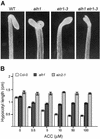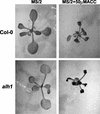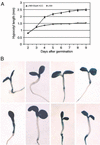The Arabidopsis mutant alh1 illustrates a cross talk between ethylene and auxin
- PMID: 12644673
- PMCID: PMC166883
- DOI: 10.1104/pp.010850
The Arabidopsis mutant alh1 illustrates a cross talk between ethylene and auxin
Abstract
Ethylene or its precursor 1-aminocyclopropane-1-carboxylic acid (ACC) can stimulate hypocotyl elongation in light-grown Arabidopsis seedlings. A mutant, designated ACC-related long hypocotyl 1 (alh1), that displayed a long hypocotyl in the light in the absence of the hormone was characterized. Etiolated alh1 seedlings overproduced ethylene and had an exaggerated apical hook and a thicker hypocotyl, although no difference in hypocotyl length was observed when compared with wild type. Alh1 plants were less sensitive to ethylene, as reflected by reduction of ACC-mediated inhibition of hypocotyl growth in the dark and delay in flowering and leaf senescence. Alh1 also had an altered response to auxin, whereas auxin levels in whole alh1 seedlings remained unaffected. In contrast to wild type, alh1 seedlings showed a limited hypocotyl elongation when treated with indole-3-acetic acid. Alh1 roots had a faster response to gravity. Furthermore, the hypocotyl elongation of alh1 and of ACC-treated wild type was reverted by auxin transport inhibitors. In addition, auxin up-regulated genes were ectopically expressed in hypocotyls upon ACC treatment, suggesting that the ethylene response is mediated by auxins. Together, these data indicate that alh1 is altered in the cross talk between ethylene and auxins, probably at the level of auxin transport.
Figures









Similar articles
-
RCN1-regulated phosphatase activity and EIN2 modulate hypocotyl gravitropism by a mechanism that does not require ethylene signaling.Plant Physiol. 2006 Aug;141(4):1617-29. doi: 10.1104/pp.106.083212. Epub 2006 Jun 23. Plant Physiol. 2006. PMID: 16798939 Free PMC article.
-
Involvement of COP1 in ethylene- and light-regulated hypocotyl elongation.Planta. 2012 Dec;236(6):1791-802. doi: 10.1007/s00425-012-1730-y. Epub 2012 Aug 14. Planta. 2012. PMID: 22890836
-
Auxin, ethylene and brassinosteroids: tripartite control of growth in the Arabidopsis hypocotyl.Plant Cell Physiol. 2005 Jun;46(6):827-36. doi: 10.1093/pcp/pci111. Epub 2005 Apr 25. Plant Cell Physiol. 2005. PMID: 15851402
-
Regulation of seedling growth by ethylene and the ethylene-auxin crosstalk.Planta. 2017 Mar;245(3):467-489. doi: 10.1007/s00425-017-2651-6. Epub 2017 Feb 10. Planta. 2017. PMID: 28188422 Review.
-
Environmental Control of Hypocotyl Elongation.Annu Rev Plant Biol. 2024 Jul;75(1):489-519. doi: 10.1146/annurev-arplant-062923-023852. Epub 2024 Jul 2. Annu Rev Plant Biol. 2024. PMID: 38012051 Review.
Cited by
-
Online, real-time detection of volatile emissions from plant tissue.AoB Plants. 2013;5:plt003. doi: 10.1093/aobpla/plt003. Epub 2013 Feb 20. AoB Plants. 2013. PMID: 23429357 Free PMC article.
-
Genetic Regulation of Ethylene Dosage for Cucumber Fruit Elongation.Plant Cell. 2019 May;31(5):1063-1076. doi: 10.1105/tpc.18.00957. Epub 2019 Mar 26. Plant Cell. 2019. PMID: 30914499 Free PMC article.
-
Multilevel interactions between ethylene and auxin in Arabidopsis roots.Plant Cell. 2007 Jul;19(7):2169-85. doi: 10.1105/tpc.107.052068. Epub 2007 Jul 13. Plant Cell. 2007. PMID: 17630276 Free PMC article.
-
A role for auxin response factor 19 in auxin and ethylene signaling in Arabidopsis.Plant Physiol. 2006 Mar;140(3):899-908. doi: 10.1104/pp.105.070987. Epub 2006 Feb 3. Plant Physiol. 2006. PMID: 16461383 Free PMC article.
-
Expression of the beta-oxidation gene 3-ketoacyl-CoA thiolase 2 (KAT2) is required for the timely onset of natural and dark-induced leaf senescence in Arabidopsis.J Exp Bot. 2008;59(8):2171-9. doi: 10.1093/jxb/ern079. Epub 2008 Apr 25. J Exp Bot. 2008. PMID: 18441338 Free PMC article.
References
-
- Abeles FB, Morgan PW, Salveit ME., Jr . Ethylene in Plant Biology. Ed 2. New York: Academic Press; 1992.
-
- Alonso JM, Hirayama T, Roman G, Nourizadeh S, Ecker JR. EIN2, a bifunctional transducer of ethylene and stress responses in Arabidopsis. Science. 1999;284:2148–2152. - PubMed
-
- Bell CJ, Ecker JR. Assignment of 30 microsatellite loci to the linkage map of Arabidopsis. Genomics. 1994;19:137–144. - PubMed
-
- Bijnen FGC, Reuss J, Harren FJM. Geometrical optimization of a longitudinal resonant photoacoustic cell for sensitive and fast trace gas detection. Rev Sci Instrum. 1996;67:2914–2923.
Publication types
MeSH terms
Substances
LinkOut - more resources
Full Text Sources
Molecular Biology Databases

